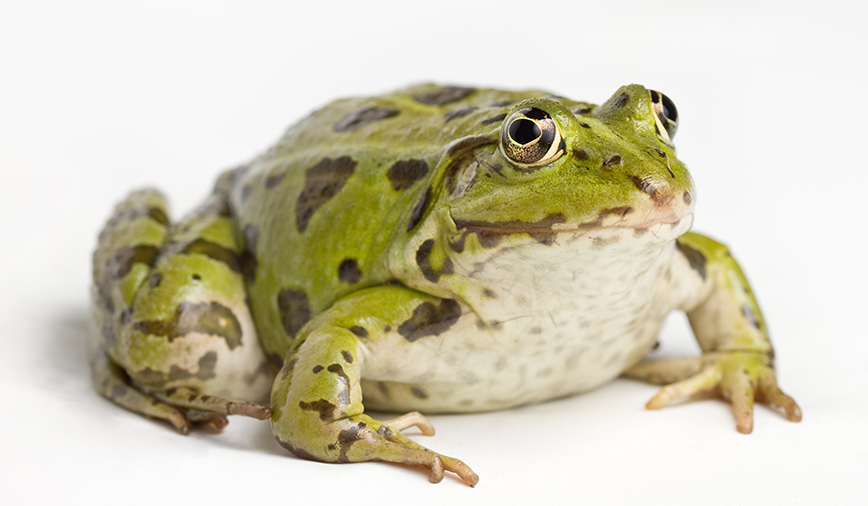I’ll bet a good number of folks spent at least part of the holiday weekend watching Wimbledon, the venerable tennis tournament that takes place “across the pond.” I know I did, particularly the marathon match on Sunday. But I also spent a considerable amount of time at the pond at Delnor Woods Park in St. Charles, watching and listening to a match of a different sort.
Just as Wimbledon is over for another year, the days of this local competition are waning. The players have been at it for several weeks now, and only the hardiest, or maybe foolhardiest, contenders persist. They’re male green frogs, and they’re vying for mates.
Green frogs are some of the most prominent residents at the Delnor pond. Though not always visible, they are certainly among the most vocal—at least at this time of year. In fact, their scientific name, Rana clamitans, pays tribute to their unique vocal stylings. Rana means frog, and clamitans references their loud calling. From late May through mid July the males send out their twangy serenade in the hopes of attracting a female.
Most field guides will tell you that the green frog’s call sounds like the plunk of a loose banjo string; maybe so, but to me their call sounds exactly like the dry cough of a bronchially challenged roommate I once had: glunk, glunk, krunk, krunk.
It may not be music to our ears, but it’s apparently proved irresistible to the lady ranids…Delnor Woods has lots of green frogs.
And, for us spectators, Delnor Woods also has lots of places to sit and enjoy the performances. There are some nice slabs of rock on the west bank of the pond, and a couple of picnic tables on the eastern edge.
Sit down for a few minutes and let the frogs get used to your presence. Then tune in your ears…but don’t close your eyes. Unlike many birds and insects that always sing but are rarely seen, the green frogs of Delnor Woods are easy to spot.
Yet they’re not the biggest frogs in the pond. No, that title goes to the bullfrog, Rana catesbeiana. (The species name here pays tribute to Mark Catesby, an 18th-century naturalist and author.)
Those same field guides that tell you about loose banjo strings also usually mention that green frogs and bullfrogs look alike. So how do you tell the difference between the two species? Color isn’t everything, nor are markings. You’ll need to look at a few factors to make a correct i.d.
True to their name, bullfrogs are big—the size of dessert plates, sometimes. Not coincidentally, they’re also the species most frequently turned into frog legs.
Green frogs, on the other hand, are smaller. The biggest males are about the size of a computer mouse.
The younger the frog, though, the more confusing the i.d. can be. Smaller bullfrogs can look very much like green frogs, and recently transformed youngsters of both species can look downright identical.
The best way to tell the two species apart is to get a look at their backs. Bullfrogs have a fold, or ridge, of skin on each side of their head that wraps around their “ears,” or tympanic membranes.
Green frogs have these folds, as well as another pair that run down either side of the back. These folds, known as dorsolateral ridges, are usually quite easy to see. (The exception would be if the green frog is extremely well fed. In these cases the folds stretch tight and can be hard to detect, much like the folds in the elastic waistband of summer shorts; you know, the ones that fit perfectly a few years ago but now have mysteriously “shrunk.”)
While you’re looking closely at the frogs, whether bull or green, test yourself to see if you can tell who’s a male and who’s a female. All you need to do is look at those “ears,” the circular membranes near the eyes. If they are considerably larger than the eye, your frog is a male; if they are about the same size as the eyes, the frog is female.
I was practicing these sorts of techniques last weekend when another call began—one I hadn’t heard since last summer. From high up in a cottonwood, the buzz of a male annual cicada droned into the evening. As the green frogs wind down their mating volleys for the year, yet another match is moving onto Centre Court.
Delnor Woods Park is located on the east side of St. Charles. East entrance is from Wing Ave; west entrance is on Route 25 across from Fulton Avenue.
Pam Otto is the manager of nature programs and interpretive services for the St. Charles Park District and can be reached at potto@stcparks.org or 630-513-4346.

